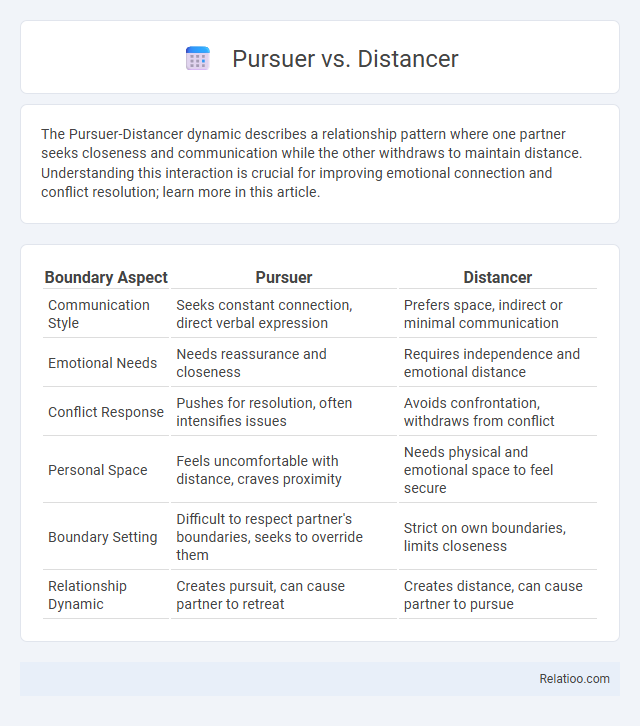The Pursuer-Distancer dynamic describes a relationship pattern where one partner seeks closeness and communication while the other withdraws to maintain distance. Understanding this interaction is crucial for improving emotional connection and conflict resolution; learn more in this article.
Table of Comparison
| Boundary Aspect | Pursuer | Distancer |
|---|---|---|
| Communication Style | Seeks constant connection, direct verbal expression | Prefers space, indirect or minimal communication |
| Emotional Needs | Needs reassurance and closeness | Requires independence and emotional distance |
| Conflict Response | Pushes for resolution, often intensifies issues | Avoids confrontation, withdraws from conflict |
| Personal Space | Feels uncomfortable with distance, craves proximity | Needs physical and emotional space to feel secure |
| Boundary Setting | Difficult to respect partner's boundaries, seeks to override them | Strict on own boundaries, limits closeness |
| Relationship Dynamic | Creates pursuit, can cause partner to retreat | Creates distance, can cause partner to pursue |
Understanding the Pursuer-Distancer Dynamic
The Pursuer-Distancer dynamic describes a common relationship pattern where one partner (the Pursuer) seeks closeness and frequent communication, while the other (the Distancer) values space and emotional distance. Understanding this dynamic is crucial for recognizing how your differing needs for intimacy and autonomy create tension and miscommunication. By identifying these roles, you can develop strategies to balance connection and independence, promoting healthier interaction in your relationship.
Psychological Roots of Pursuer and Distancer Roles
The psychological roots of pursuer and distancer roles often stem from early attachment experiences, where pursuers typically develop from unmet needs for connection and fear of abandonment, driving them to seek reassurance and closeness. Distancers, on the other hand, usually arise from a need for independence and self-protection developed in response to feeling overwhelmed or invaded, causing them to withdraw emotionally to maintain control and safety. Understanding your position in this dynamic can promote healthier communication and reduce relational tension by acknowledging these deep-seated emotional patterns.
Key Traits of Pursuers in Relationships
Pursuers in relationships exhibit a strong desire for closeness and frequent communication, often seeking reassurance and emotional connection from their partners. They tend to respond to distance by intensifying their efforts to connect, which can sometimes overwhelm distancers who value autonomy and space. Understanding these key traits helps in navigating the pursuer-distancer dynamic by promoting balanced boundaries and empathy.
Common Behaviors of Distancers
Distancers often exhibit a tendency to withdraw emotionally and physically during conflicts, creating space to avoid intense feelings or confrontation. Common behaviors include shutting down communication, avoiding eye contact, or physically leaving the situation to maintain control over their emotions. Understanding these patterns can help You navigate challenges and foster healthier interactions between Pursuers and Distancers.
Signs You’re in a Pursuer-Distancer Cycle
Signs you're in a pursuer-distancer cycle include one partner constantly seeking connection and reassurance while the other withdraws or creates physical and emotional distance. This dynamic often features increased arguments, feelings of frustration, and a growing emotional disconnect as the pursuer intensifies their efforts and the distancer retreats further. Recognizing patterns such as avoidance of intimacy by the distancer and persistent demands for closeness by the pursuer is crucial for breaking the cycle and fostering healthier communication.
Emotional Impact on Both Partners
The Pursuer often experiences anxiety and frustration from feeling unheard, which can heighten their urge to seek closeness, while the Distancer may feel overwhelmed and pressured, leading to emotional withdrawal and a need for space. This dynamic creates a cycle where Your attempts to connect can unintentionally push your partner further away, intensifying feelings of rejection and loneliness for both. Understanding these emotional impacts helps break the negative pattern, fostering healthier communication and emotional intimacy.
Communication Patterns in Pursuer-Distancer Relationships
Pursuer-distancer communication patterns often involve the pursuer seeking closeness and reassurance while the distancer seeks space and autonomy, leading to repeated cycles of pursuit and withdrawal. This dynamic can create heightened emotional tension, as the pursuer's attempts to engage may trigger the distancer's need for distance, resulting in frustration and misunderstandings. Effective communication strategies emphasize recognizing these patterns, promoting empathy, and establishing clear boundaries to foster balanced connection and individual autonomy.
Breaking the Pursuer-Distancer Cycle
Breaking the Pursuer-Distancer cycle requires recognizing the patterned emotional responses where the pursuer seeks connection through engagement while the distancer withdraws to maintain autonomy. Effective strategies include increasing self-awareness to manage anxiety-driven pursuit behaviors and encouraging open, non-defensive communication that respects the distancer's need for space. Couples therapy techniques like Emotionally Focused Therapy emphasize creating a safe environment for vulnerability and mutual responsiveness, ultimately reducing polarization in the relationship dynamic.
Strategies for Healthy Relationship Balance
In relationships where one partner is a pursuer and the other a distancer, maintaining a healthy balance requires clear communication and mutual respect for each other's emotional needs. Pursuers can benefit from practicing patience and providing space, while distancers should work on expressing their feelings openly to reduce withdrawal tendencies. Establishing boundaries and regularly checking in fosters understanding, helping both partners feel secure and connected despite differing attachment styles.
When to Seek Professional Help
Persistent patterns of Pursuer and Distancer dynamics in relationships often lead to heightened emotional distress and communication breakdowns. Seek professional help when efforts to resolve conflicts independently result in recurring frustration, emotional withdrawal, or when one partner feels chronically overwhelmed by pursuit or avoidance behaviors. Early intervention with a qualified therapist can promote healthier communication techniques and foster emotional understanding between Pursuers and Distancers.

Infographic: Pursuer vs Distancer
 relatioo.com
relatioo.com